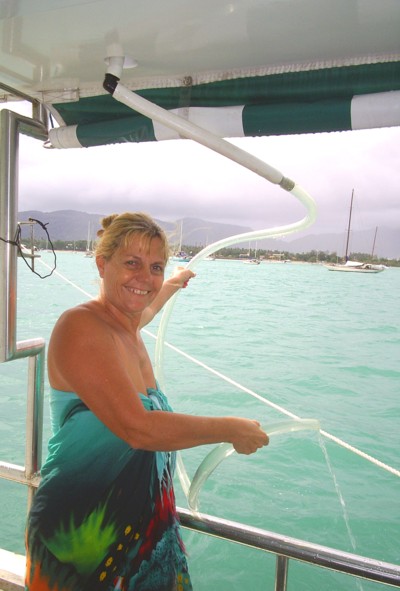 A Cheesy picture of our water collection system. The hoses go in the tank fillers not overboard like this!
A Cheesy picture of our water collection system. The hoses go in the tank fillers not overboard like this! (NB. This was part of an article we wrote for Passagemaker Magazine published in August 2007 . Hence the Americanisms.)
When planning Lifeline’s conversion, we gave a lot of thought to water. In many parts of South East Asia, even where tap water is available, it is not drinkable. Local people (and boaters who can’t catch or store enough) have to buy and cart water in 1 – 20 litre quantities. Even yachts in marinas have to do this.
At the same time, when it rains it really comes down. Why not catch and use rainwater and save ourselves the hassle of carting it? Traditionally, cruising sailboats try to catch rain water in awnings over their cockpits. Power boats, with their large flat, hard roof areas are actually much better suited to the task.
Lifeline’s water collection system is simple. The 375 sq ft of cabin roof has a “fiddle” around its edge to stop water spilling over. Instead of running away and being wasted, rainwater is channelled through 4 “through-hull fittings” in the roof. The fittings are connected to 1” hoses which can go over the side or send water straight into our deck fillers to our two 200 gallon water tanks. Depending on the trim of the boat, the forward or aft hoses are most effective.
When it rains solidly, we leave it half an hour before putting the hoses into our tanks, to ensure the decks are clean. We treat the water with chlorine bleach in the proportions suggested by Elaine Morgan in “Cruising South East Asia. Volume II” (2 tablespoons for each 200 gallon tank.) A Cheesy picture of our water collection system. The hoses go in the tank fillers not overboard like this!
A Cheesy picture of our water collection system. The hoses go in the tank fillers not overboard like this!
Managing the Water We’ve Caught
Although we have an abundance of water in the wet season, during the dry season it may not rain for several months, the situation we had while travelling in Indonesia. This is where water frugality comes in.
When we left Australia we employed our usual water saving methods. These are simple and the usual ones used on cruising boats eg every day boat showers where you wet yourself, turn off the shower; soap up, turn on the shower and rinse off; don’t leave the tap running while cleaning teeth; use shower water to clean the toilet etc. We knew from our experience on the Australian coast that, even cooling off in the shower a couple of times a day, we could easily make our water last at least 6 weeks.
We planned that when our water tanks got down to half full we would go into full saving mode where we washed up in salt water and, if necessary, bathed in salt with only a cup of fresh water to rinse, followed by talcum powder. We never had to do this. After 6 weeks, before we got down to half full, we had a squall that filled us up again.
Why Not A Watermaker?
Before leaving Australia we did consider a watermaker, especially as we had read of yachts in South East Asia who recommended them.
In the end we rejected the idea primarily because we already had an efficient, simple system. Plus, we realised that for the price we would have to pay for one, we could cruise for several months. For us, being careful with water is no hardship.
Every day we are thankful we made the right decision.
Of the yachts we know who have watermakers, ALL OF THEM had mechanical problems which could not be fixed in Indonesia. Multiplying the problem, because they had watermakers none of them had large water tanks but all of them were used to using copious amounts of water each day. So they would run out of water quickly and have to stop many places to try to source potable water and then spend time humping it. We, on the other hand, went where we wanted, showered several times a day and never had a moment’s worry about the quality of our water.
The last straw is this! Our friends with them tell us that watermakers need relatively clean, unsedimented water to do their job. So they can’t use their watermakers in the harbours and marinas here, and are still buying and hauling water. With our excess water, we sometimes fill jerry cans from our roof for other cruising yachts. Guess what – they all have watermakers on board.